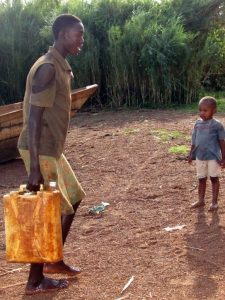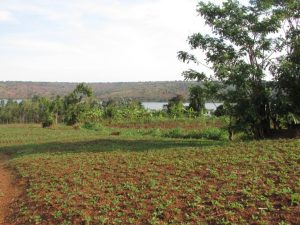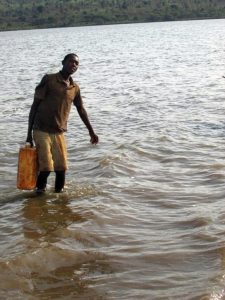This project is made possible through the partnership of WATER CHARITY and the NATIONAL PEACE CORPS ASSOCIATION. ![]()
Location
Rukoma and Gafunzo, Sake Sector, Ngoma District, Eastern Province, Rwanda
 Community Description
Community Description
Sake is located in the Eastern Province, District of Ngoma. Ngoma is a very large district which divides into sectors, which then divides into cells and then villages. Sake is one of twenty sectors in Ngoma, which has 4 cells, Rukoma, Gafunzo, Kibonde, and Nkanga. These four cells have a total of 34 villages, with a population of 25,700 community members.
There are two beautiful lakes that run through Sake, Lake Sake, and Lake Mugesera. Sake neighbors a sector call Bugesera which happens to be the hottest place in Rwanda, which means living in Sake can be extremely hot especially during the dry seasons. Because Sake is in the Eastern Province, even the rainy seasons are not as wet as other areas.
In Sake, Gafunzo is considered the main town as there are many shops, the bus park, and most importantly the market.
Rukoma is where the health center is located and it services 25,700 community members. It is also the home of the Catholic Church in Sake where the majority of the community attends services.
Sake has a wonderful community environment. The people in Sake are both friendly and welcoming. Children enjoy seeing foreigners come in and out of the villages and often times try to use English when approaching them. The majority of the community members are cultivators.
A major landmark in Sake is the gas station located near the Catholic Church (nonaffiliated). Many times there is heavy traffic due to construction being done by the government and also because the road leads the District Hospital. Sake has one of the most beautiful sunsets that reflects off the water.
Problem Addressed
Living close to open water, community members use the lake as a water source. This is a major issue because lake water is a health hazard. Because of the lack of water stations in the villages, community members rely solely on the lakes to provide water for their families. There is a high incidence of water-borne illness in Sake, as reported by the health center, with many mothers and children who use lake water as a water source.
 Sake has 34 villages and a limited number of water stations nearing these villages. To get to a water station, some community members travel far. A jerry can contain 20 liters, which is a heavy load for a mother caring a child on her back. Because mothers are the primary caretakers, they are responsible for the majority of the household chores including fetching water. Many children can be seen fetching water and carrying them home to their families.
Sake has 34 villages and a limited number of water stations nearing these villages. To get to a water station, some community members travel far. A jerry can contain 20 liters, which is a heavy load for a mother caring a child on her back. Because mothers are the primary caretakers, they are responsible for the majority of the household chores including fetching water. Many children can be seen fetching water and carrying them home to their families.
Rukoma and Gafunzo cells are the cells closest to the lakes and have very few water stations, resulting in community members using the lake as a water source.
Project Description
This project is to build a water system comprised of a water line connected to a new water station in each of three villages in Sake: Kizanye, Nyabuhoro, and Nyakagezi.
All of the work done will be done manually, with the help of the people of the community and the engineers who will lay the pipes.
The funds provided by Water Charity will be used to buy the materials and pay the engineers. The Sector officials (appointed officials of the sector) will pay for the community labor.
The implementation plan for this project is roughly five months:
First, the engineers will buy the materials- (3 days)
Second, the community will dig the path for the pipes (8 weeks)
Third, the engineers will lay the pipes for the water stations.
The water pipes will be connected to the Gasetsa water plant in Sake. (4 weeks)
The last month will be used to clean up the site and cover the pipes and to make sure everything is in place.
 In order to build the water station in Sake, a trench will be dug from Gafunzo where the water source is located to where the water stands will be built. The trenches to all three villages will be 0.9 meters deep and 0.5 meters wide. The trench from Gafunzo to Nyabuhoro is 1 km long continuing another 1.5 km from Nyabuhoro to Kizanye and extending the right of Nyabuhoro to Nyakagezi for an additional 2 km.
In order to build the water station in Sake, a trench will be dug from Gafunzo where the water source is located to where the water stands will be built. The trenches to all three villages will be 0.9 meters deep and 0.5 meters wide. The trench from Gafunzo to Nyabuhoro is 1 km long continuing another 1.5 km from Nyabuhoro to Kizanye and extending the right of Nyabuhoro to Nyakagezi for an additional 2 km.
Since the trench will lead to three villages they will be 2,400 laborers working to dig the trench manually using shovels. After the trench is dug, a foundation will be put in place for the pipes.
Stones will be placed in the trench, and then sand placed to protect the pipes from damages that may occur from earth movement.
Next, the galvanized pipe will be laid in the trench once a stable foundation is achieved. The pipes will be one continuous pipe from Gafunzo (location of the water tanks) to Nyabuhoro, Nyabuhoro to Kizanye and Nyabuhoro to Nyakagezi.
After the pipes are laid the laborers will place the small sand on top and around the pipes and then add small stones to ensure stability.
Finally, the laborers will come back to backfill the trench using the soil that was dug up from the trench.
The water stand will then be built. First sand will be placed around the area. Plank wood will be placed in an 8” x 16” rectangular shape, which will then be filled with cement surrounding an upright above-ground pipe. Finally, a cylinder-shaped cement block will be placed around the pipe for stabilization.
Project Impact
This project will benefit all 2,618 members of the three communities reached.
Peace Corps Volunteer Directing Project
Shinae Meylor
Monitoring and Maintenance
Once the piping is completed the community and the Sector office will take responsibility for the maintenance of the water stands. Each person that comes to the stand for water will pay 20 francs a jerry-can. The money collected from the community members will be used to pay the water company and the person responsible for collecting the money (community health worker).
The Executive Secretary will be responsible for any repairs that might occur in the future. She is responsible for actively communicating with the community members to assure that they are receiving quality water and that the pipe stands are available and working in the community.
Fundraising Target
$4,900
Funds raised in excess of the project amount will be allocated to other projects in the country.
Donations Collected to Date
$65
ADOPT THIS PROJECT BY CONTRIBUTING THE DOLLAR AMOUNT OF THE PROJECT
Donations of any amount will be appreciated. The full amount will give you “naming rights” if that is something you would like.
Dollar Amount Needed
$4,835 ![]()